Change Language :
iglide® J3 - material data
| General features | Unit | iglide® J3 | Test method |
|---|---|---|---|
| Density | g/cm³ | 1.42 | |
| Color | yellow | ||
| Max. moisture absorption at 73°F/50% R. H. | Wt.-% | 0.3 | DIN 53495 |
| Max. moisture absorption | Wt.-% | 1.3 | |
| Coefficient of surface friction, dynamic, against steel | µ | 0.06 - 0.20 | |
| P x v value, max. (dry) | psi x fpm | 14,000 |
| Mechanical properties | Unit | iglide® J3 | Test method |
|---|---|---|---|
| Modulus of elasticity | psi | 391,600 | DIN 53457 |
| Tensile strength at 68° F | psi | 10,150 | DIN 53452 |
| Compressive strength | psi | 8,702 | |
| Maximum recommended surface pressure (68° F) | psi | 6,527 | |
| Shore D hardness | 73 | DIN 53505 |
| Physical and thermal properties | Unit | iglide® J3 | Test method |
|---|---|---|---|
| Upper long-term application temperature | °F | +194 | |
| Upper short-term application temperature | °F | +248 | |
| Lower application temperature | °F | -58 | |
| Thermal conductivity | W/m x K | 0.25 | ASTM C 177 |
| Coefficient of thermal expansion (at 73° F) | K^(-1) x 10^(-5) | 13 | DIN 53752 |
| Electrical properties | Unit | iglide® J3 | Test method |
|---|---|---|---|
| Specific volume resistance | Ωcm | > 10^12 | DIN IEC 93 |
| Surface resistance | Ω | > 10^12 | DIN 53482 |
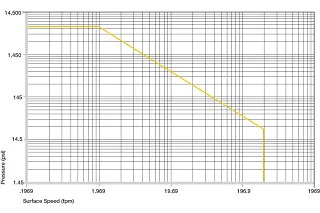
Permissible p x v values
Permissible p x v values for iglide® J3 plastic bushings running dry against a steel shaft, at 68°F.
iglide® J3 is our new material with increased wear resistance at low to medium loads and high speeds. The service life is up to 300% higher than in iglide® J - the proven top endurance runner material.
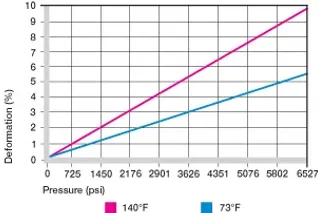
Deformation under load and temperatures
Surface Pressure
The graph shows the elastic deformation of iglide® J3 with radial loads. Under the maximum recommended surface pressure of 5,802 psi, the deformation is less than 6%. The plastic deformation is minimal up to a pressure of approximately 14,500 psi. The possible plastic deformation depends on the applied pressure, as well as other external factors.
Maximum surface speed
Permitted surface speeds
iglide® J3 has been developed for medium to high surface speeds. The maximum values shown in the table can only be achieved at low pressure. At the given speeds, friction can cause a temperature increase to maximum permissible levels. In practice though, this temperature level is rarely reached, due to varying application conditions.
| fpm | Rotary | Oscillating | Linear |
|---|---|---|---|
| Continuous | 295 | 216 | 1575 |
| Short-term | 591 | 413 | 1969 |
Temperatures
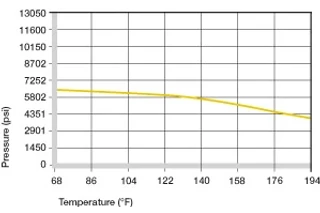
Recommended maximum permissible static surface pressure of iglide® J3 as a result of the temperature
iglide® J3 plastic bushings can be used between -58°F and +194°F. The short-term permitted maximum temperature is +248°F. The temperatures prevailing in the bushing system also have an influence on the bushing wear. The wear increases with rising temperatures, and the influence is particularly marked from 194°F temperature onward.
| iglide® J3 | Application temperature |
|---|---|
| Lower | -58 °F |
| Upper, long-term | +194 °F |
| Upper, short-term | +248 °F |
| Additional axial securing | +140 °F |
Friction and wear
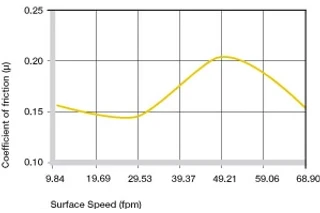
Figure 2.4: Coefficients of friction dependent on the surface speed, p = 108 psi
Similar to wear resistance, the coefficient of friction µ also changes with the load. The coefficient of friction decreases with increasing loads, as it shows a clear minimum at surface speeds up to 29 fpm. The friction and wear are also dependent, to a large degree, on the shaft material. Shafts that are too smooth increase both the coefficient of friction and the wear of the bushing. For iglide® J3 a ground surface with an average roughness 4 to 12 rms is recommended.
Coefficients of friction for iglide® J3 against steel shaft
(Shaft finish = 40 rms, 50 HRC)
| iglide® J3 | Dry | Grease | Oil | Water |
|---|---|---|---|---|
| Coefficients of friction μ | 0.06–0.20 | 0.09 | 0.04 | 0.04 |
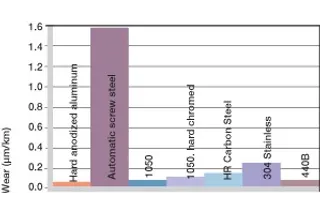
Wear, rotating application with different shaft materials, p = 108 psi, v = 98 fpm
Shaft Materials
The graphs on the left show the results of testing different shaft materials with plastic bushings made of iglide® J3. The graph shows that iglide® J3 can be combined with various shaft materials. At low pressures, hard anodized aluminum shaft, 440B Steel and 1050 steel shafts proved to be the best. But even in combination with other shaft materials, except for free cutting steel, iglide® J3 plastic bushings achieve excellent wear values. The graph shows that the difference between shaft materials increase with increasing loads. Hard chromed or 304 stainless shafts are best at pressure from 290 psi in rotation movement.
The graph below left shows rotating and oscillating tests in comparison. With higher load, the wear increases more for rotating than for oscillating movements.
Chemical resistance
iglide® J3 plastic bushings are resistant to diluted alkalis and very weak acids as well as to fuels and all kinds of lubricants. The low humidity absorption allows them to be used in wet or humid environment. The bushings made of iglide® J3 are resistant to many cleaning agents used in the food industry.
+ resistant
0 partially resistant
- non-resistant
| Medium | Resistance |
|---|---|
| Alcohols | + |
| Hydrocarbons, chlorinated | + |
| Greases, oils, without additives | + |
| Fuels | + |
| Weak acids | 0 to - |
| Strong acids | - |
| Weak alkaline | + |
| Strong alkaline | + to 0 |
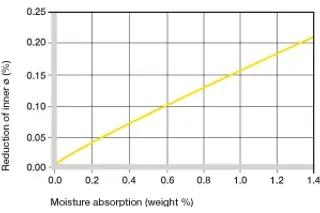
Effect of moisture absorption on iglide® J3 plastic bushings
Radioactive rays
Resistant up to a radiation intensity of 1 x 104 Gy
UV-resistant
iglide® J3 plastic bushings change color under the influence of UV rays. However the hardness, compressive strength and the wear resistance of the material do not degrade.
Vacuum
In application in vacuum, the potentially existent moisture content is degassed. For this reason only the dry iglide® J3 plastic bushings are suitable for vacuum.
Electrical properties
Electrical properties of iglide® J3 (electrically insulating)
| Specific volume resistance | > 10^12 Ωcm |
| Surface resistance | > 10^12 Ω |
Installation tolerances
iglide® J3 plastic bushings are standard bushings for shafts with h-tolerance (recommended minimum h9). The bushings are designed for press-fit in a housing with h7 tolerance. After the installation in a housing with nominal diameter, the inner diameter of the bushing automatically adjusts to the E10 tolerance. Compared to the installation tolerance, the inner diameter varies according to moisture absorption.
| Diameter d1 [mm] | Shaft h9 [mm] | iglide® J3 E10 [mm] | Housing H7 [mm] |
|---|---|---|---|
| Up to 3 | 0 - 0.025 | +0,014 +0.054 | 0 +0.010 |
| > 3 to 6 | 0 - 0.030 | +0,020 +0.068 | 0 +0.012 |
| > 6 to 10 | 0 - 0,036 | +0,025 +0.083 | 0 +0.015 |
| > 10 to 18 | 0 - 0.043 | +0,032 +0.102 | 0 +0.018 |
| > 18 to 30 | 0 - 0.052 | +0,040 +0.124 | 0 +0.021 |
| > 30 to 50 | 0 - 0.062 | +0,050 +0.150 | 0 +0.025 |
| > 50 to 80 | 0 - 0.074 | +0,060 +0.180 | 0 +0.030 |
| > 80 to 120 | 0 - 0.087 | +0,072 +0.212 | 0 +0.035 |
| > 120 to 180 | 0 - 0.100 | +0,085 +0.245 | 0 +0.040 |



